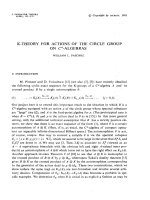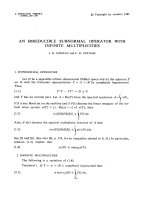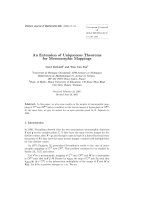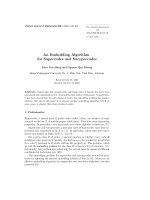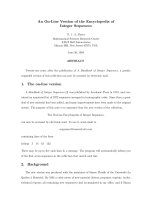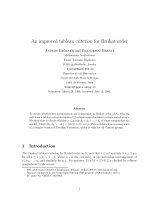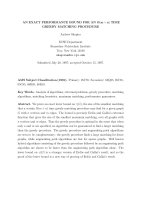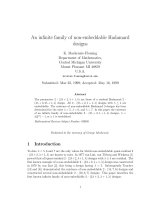Báo cáo toán học: "An algorithmic Friedman–Pippenger theorem on tree embeddings and applications" ppsx
Bạn đang xem bản rút gọn của tài liệu. Xem và tải ngay bản đầy đủ của tài liệu tại đây (208.76 KB, 14 trang )
An algorithmic Friedman–Pippenger theorem on
tree embeddings and applications∗
Domingos Dellamonica Jr.
Department of Mathematics and Computer Science, Emory University
400 Dowman Dr., Atlanta, GA, 30322, USA
Yoshiharu Kohayakawa
Instituto de Matem´tica e Estat´
a
ıstica, Universidade de S˜o Paulo
a
Rua do Mat˜o 1010, 05508–090 S˜o Paulo, Brazil
a
a
Submitted: Apr 29, 2008; Accepted: Oct 2, 2008; Published: Oct 13, 2008
Mathematics Subject Classification: 05C05, 05C85
Abstract
An (n, d)-expander is a graph G = (V, E) such that for every X ⊆ V with |X| ≤
2n − 2 we have |ΓG (X)| ≥ (d + 1)|X|. A tree T is small if it has at most n vertices
and has maximum degree at most d. Friedman and Pippenger (1987) proved that
any (n, d)-expander contains every small tree. However, their elegant proof does
not seem to yield an efficient algorithm for obtaining the tree. In this paper, we
give an alternative result that does admit a polynomial time algorithm for finding
the immersion of any small tree in subgraphs G of (N, D, λ)-graphs Λ, as long as G
contains a positive fraction of the edges of Λ and λ/D is small enough. In several
applications of the Friedman–Pippenger theorem, including the ones in the original
paper of those authors, the (n, d)-expander G is a subgraph of an (N, D, λ)-graph
as above. Therefore, our result suffices to provide efficient algorithms for such
previously non-constructive applications. As an example, we discuss a recent result
of Alon, Krivelevich, and Sudakov (2007) concerning embedding nearly spanning
bounded degree trees, the proof of which makes use of the Friedman–Pippenger
theorem.
We shall also show a construction inspired on Wigderson–Zuckerman expander
graphs for which any sufficiently dense subgraph contains all trees of sizes and
maximum degrees achieving essentially optimal parameters.
Our algorithmic approach is based on a reduction of the tree embedding problem
to a certain on-line matching problem for bipartite graphs, solved by Aggarwal et
al. (1996).
Research partially supported by FAPESP and CNPq through a Tem´tico-ProNEx project
a
(Proc. FAPESP 2003/09925-5) and by CNPq (Proc. 485671/2007-7 and 486124/2007-0). The first author
is supported by a CAPES/Fulbright Scholarship and the second author was partially supported by CNPq
(Proc. CNPq 308509/2007-2).
∗
the electronic journal of combinatorics 15 (2008), #R127
1
1
Introduction
Let G = (V, E) be a graph. We say that G is an (n, d)-expander if for every X ⊆ V
with |X| ≤ 2n − 2 we have |ΓG (X)| ≥ (d + 1)|X|, where, as usual, we write ΓG (X) for the
neighborhood of X in G. A tree T is called (n, d)-small, or simply small, if |V (T )| ≤ n
and ∆(T ) ≤ d, that is, if it has at most n vertices and it has maximum degree ∆(T ) =
maxv∈V (T ) dT (v) at most d. An embedding of a graph H in a graph G is simply an edgepreserving injection f : V (H) → V (G). The following elegant theorem was discovered by
Friedman and Pippenger [8].
Theorem 1.1. Any (n, d)-expander graph contains every small tree.
Theorem 1.1 generalizes to trees the essence of a well known result of P´sa [13],
o
concerning the existence of long paths in expanders.
Organization of the Paper
In Section 2 we show how one can obtain an algorithmic analogue of Theorem 1.1 when
the graph is a constant density subgraph of a pseudorandom graph; see Theorem 2.3. In
Section 3, by making use of Theorem 2.3 instead of the original Friedman–Pippenger Theorem in the argument of Alon, Krivelevich and Sudakov [3], we can turn their result—the
embedding of nearly spanning bounded degree trees—into an algorithmic result. Section 4
deals with the explicit construction of tree-universal graphs where tree embeddings can
be computed efficiently.
2
On-line Games and Tree Embeddings
We reduce the problem of finding a tree embedding to an on-line matching game that we
will call G. The game G can be described as follows. Let H = (U, W ; E) be a bipartite
graph. At each step there is a matching M (initially empty), an adversary requests a
vertex u ∈ U , where u is not covered by M , and we are supposed to extend M (by adding
a single edge) in order to cover u.
Aggarwal et al. [1, 2] provided a polynomial time algorithm that can find a matching
of size n against any adversary provided that the graph H is such that, for every X ⊆ U
with |X| ≤ n, even after at most half the edges incident to every vertex of X are removed,
there remains at least 2|X| neighbors of X. This result is given by the theorem below.
Definition 2.1. Let G be a graph and v ∈ V (G). We denote by ∂G (v) the set of edges
incident to v in G, that is ∂G (v) = {e ∈ E(G) | v ∈ e}.
Theorem 2.2 ([1]). Let H be a bipartite graph with classes U, W . Suppose H is such
that for every X ⊆ U , with |X| ≤ n, and F ⊆ E(H) such that |F ∩ ∂(x)| ≤ dH (x)/2 for
every x ∈ X, we have |ΓH−F (X)| ≥ 2|X|. There is a polynomial time algorithm A that
can find a matching of size n in the game G against any adversary.
the electronic journal of combinatorics 15 (2008), #R127
2
In what follows we show how the problem of finding an embedding of a given tree
can be reduced to the on-line game G. We also describe some sufficient conditions for
a graph G that guarantee that the on-line algorithm A can be used in order to find
successfully an embedding of any (n, d)-small tree in G.
We now introduce a key property that synthesizes a sufficient condition for the success
of the reduction of the tree embedding problem. Roughly speaking, we require that for
any small set X, after at most half the edges incident to each vertex of X are removed,
X still has many neighbors.
Property P(n, d). For all X ⊆ V (G) with |X| ≤ n − 1 and for any set F ⊆ E(G) such
that |F ∩ ∂G (x)| ≤ dG (x)/2 for every x ∈ X, we have |ΓG−F (X)| ≥ 2d|X| + 1.
Theorem 2.3. Let G be a graph satisfying Property P(n, d). There is a polynomial time
algorithm to find an embedding of any (n, d)-small tree T into G.
A preliminary version of this paper appeared in [7]. In that version, there was a flaw in
the proof which forced us to change the embedding strategy. Although we have lost much
of the generality in the result, for all applications considered in [7], corollaries derived
from Theorem 2.3 are applicable.
Proof. First, define a bipartite graph H = H(G) with vertex classes U and W as follows.
Let U consist of d copies of each vertex of G — formally, we let U = V (G) × {1, . . . , d}
— and let W = {v | v ∈ V (G)} consist of single copies of the vertices of G. For
each {u, v} ∈ E(G) and j ∈ {1, . . . , d} we put both {(u, j), v } and {(v, j), u } in E(H).
Let T1 T2 · · · Tk = T be a sequence of trees such that Ti+1 = Ti + wi with wi
being a leaf of Ti+1 for all i = 1, . . . , k − 1, where k = |V (T )| ≤ n. Let vi ∈ V (Ti ) be the
(unique) vertex adjacent to wi in V (Ti+1 ) for i = 1, . . . , k − 1. Note that w1 , . . . , wk−1
are all distinct; indeed, these are all the vertices of T , except for the vertex r = v1 in T1 ,
which we could think of as the “root” of T . Let us moreover observe that, if v ∈ V (T ),
then the number of indices j for which we have vj = v is precisely the number of children
that v has in the rooted tree (T, r).
Our procedure consists in building an embedding f : V (T ) → V (G) by a sequence of 1vertex extensions of any trivial one-vertex embedding. Let f1 : v1 → x1 be an embedding
of T1 . Let H be the graph obtained from H after the deletion of the vertex x1 ∈ W .
We now play the game G against the algorithm A on the graph H . Therefore, we
give a sequence of requests u1 , u2 , . . . ∈ U and A tries to fulfill our requests returning
edges {u1 , z1 }, {u2 , z2 }, . . . ∈ E(H ) with all these edges independent.
First, let us define our strategy in the game. Suppose in step i we have an embedding fi : V (Ti ) → V (G). Let xj = fi (vj ) for 1 ≤ j ≤ i. We proceed by requesting the
vertex ui = (xi , #{j | j ≤ i, xj = xi }) ∈ U . Let {ui , zi } be the edge selected by algorithm A to cover ui . Extend fi by setting fi+1 (wi ) = zi and fi+1 |V (Ti ) ≡ fi . Proceed to
step i + 1 (or stop, if the embedding of T is complete).
We have to show that the above procedure actually produces embeddings and that
algorithm A always finds an edge to cover the given request and succeeds in extending
the matching. The proof will follow by induction. The invariants holding before step i
the electronic journal of combinatorics 15 (2008), #R127
3
are: (1) w ∈ W is covered by the matching given by A if and only if w ∈ fi (Ti ) \ {x1 };
(2) fi is an embedding of Ti into G. Let us assume, for now, that A always provides an
edge to extend the matching. Clearly, the invariants hold for i = 1.
Suppose that, for all j < i the invariants hold. Notice that, since ∆(T ) ≤ d, the
vertex ui is well defined. Given that {ui , zi } was selected by A to extend the matching,
the map fi+1 is defined so that fi+1 (Ti+1 ) = fi (Ti ) ∪ {zi } (with zi = x1 ) and thus (1) does
follows. By the definition of H , we have {xi , zi } ∈ E(G), but that is the same as saying
that {fi+1 (vi ), fi+1 (wi )} ∈ E(G), which implies that fi+1 preserves all the edges E(Ti+1 ) =
E(Ti ) ∪ {vi wi }, since fi preserves E(Ti ). Note also that invariant (1) implies that fi+1 is
injective. Therefore (2) does follow.
We conclude that, as long as the algorithm can provide an edge that extends the
matching, we are able to extend the tree embedding. By assumption, Property P(n, d)
holds for G and we shall prove that this property implies that, for every set X ⊆ U
with |X| ≤ n − 1, even after at most half of the edges incident to each x ∈ X are removed
from the graph H , the set X still has at least 2|X| neighbors in H .
Suppose F ⊆ E(H ) is such that |F ∩∂H (x)| ≤ dH (x)/2 for all x ∈ X. Let π : X → V
be the projection onto the first coordinate and set
F =
v∈π(X)
{v, w} ∈ E(G) {z, w } ∈ F for all z ∈ π −1 (v) .
We claim that |ΓH −F (X)| ≥ |ΓG−F (π(X))| − 1 and that |F ∩ ∂G (v)| ≤ dG (v)/2 for
all v ∈ π(X). The first assertion follows from the fact that if we have w ∈ ΓG−F (π(X)) \
{x1 } then w ∈ ΓH −F (X), since if v ∈ π(X) and {v, w} ∈ E(G)\F we must have some z ∈
π −1 (v) such that {z, w } ∈ F and thus w ∈ ΓH −F (X). The second assertion follows from
/
the assumption on F since dH (x) ≤ dG (π(x)) and |F ∩ ∂H (x)| ≥ |F ∩ ∂G (π(x))| for
all x ∈ X. By Property P(n, d) we have |ΓH −F (X)| ≥ 2d|π(X)| ≥ 2|X|.
From the proof of Theorem 2.3 above one can actually get a stronger result, as follows.
Corollary 2.4. Let T be a rooted, (n, d)-small tree and let G be a graph satisfying P(n, d).
Let r ∈ V (T ) be the root of T and let v ∈ V (G) be any given vertex of G. The embedding f
obtained by Theorem 2.3 can be forced to be such that f : r → v.
Proof. Just take the sequence T1 T2 · · ·
fix x1 = v in the proof of Theorem 2.3.
Tk = T such that T1 is just the root r and
We next give a central definition.
Definition 2.5. An (N, D, λ)-graph is a regular graph with N vertices, degree D, and
with all the eigenvalues except the largest ≤ λ in absolute value.
We denote by eG (X, Y ) (or simply e(X, Y ) when G is clear from the context) the
number of pairs (x, y) ∈ X × Y such that {x, y} ∈ E(G). Note that eG (X, Y ) counts the
number of edges with one endpoint in X and the other endpoint in Y , with edges induced
by X ∩ Y counted twice. We let e(X) = e(X, X)/2, so that e(X) counts the number of
edges induced by X.
the electronic journal of combinatorics 15 (2008), #R127
4
Lemma 2.6 (Edge Distribution Estimate). Let Λ be an (N, D, λ)-graph. For any
two sets of vertices X, Y ⊆ V (Λ), we have
e(X, Y ) −
|X| |Y |D
≤ λ |X| |Y |.
N
We now state a technical lemma that will be useful in the proof of the main theorem
of this section and also in the application that follows.
Lemma 2.7. Let Λ be an (N, D, λ)-graph. Let β > 0 be a constant. Suppose
√
n(1 + 4d)
λ
β
>
+ (1 + 2d).
2
2N
D
(1)
Let G ⊆ Λ be such that δ(G) = minv∈V (G) dG (v) ≥ βD. Then G satisfies Property P(n, d).
Proof. Let X ⊆ V (G) such that r = |X| ≤ n − 1. Suppose that Property P(n, d) fails
for this particular set. This means that there is a set F ⊆ E(G) such that |F ∩ ∂G (v)| ≤
dG (v)/2 for all v ∈ X and |ΓG−F (X)| ≤ 2d|X|. Let T = ΓG−F (X) \ X. By assumption,
we have eG (X) + eG (X, T ) ≥ |X|δ(G)/2 ≥ rβD/2. From the edge estimates in Λ we have
√
r 2 D(1 + 4d)
+ λr 1 + 2d .
2N
eΛ (X) + eΛ (X, T ) ≤
But, by (1), the right side above is smaller than rβD/2, a contradiction.
Theorem 2.8. Let Λ be an (N, D, λ)-graph. Let α > 0 be a constant. Suppose
λ<
αD
√
12(1 + 2d)
(2)
and
6n
(4d + 1).
(3)
α
Let G be any subgraph of Λ with |E(G)| ≥ αDN/2 = α|E(Λ)|. We can obtain, in
polynomial time, a subgraph of G satisfying Property P(n, d).
N>
Proof. Let G be a graph as above. We will obtain a graph G from G by deleting vertices until δ(G ) ≥ αD/3. The procedure is quite simple: if there is a vertex v in G
with dG (v) < αD/3 we delete it.
We prove that this procedure stops before G has too few vertices (or no vertex at
all). Suppose that in some step we deleted γN vertices. Then G still has (1 − γ)N
vertices and at least αDN/2 − γαDN/3 edges. By the above edge distribution estimate
for (N, D, λ)-graphs (Lemma 2.6) we have
1
1
(1 − γ)2 N 2 D λ
αDN − γαDN ≤
+ (1 − γ)N
2
3
2N
2
(1 − γ)2 DN
≤
+ λN.
2
the electronic journal of combinatorics 15 (2008), #R127
5
Dividing both sides by DN and using that γ ≤ 1, we get
(1 − γ)2
λ
α
≤
+ .
6
2
D
In particular, by our choice of parameters, λ/D ≤ α/12 and hence G has size ≥ α/6·N .
Since, by (2) and (3),
√
α
λ
> (1 + 2d)
12
D
and
α
n(1 + 4d)
>
,
12
2N
taking β = α/3 in Lemma 2.7 proves that G satisfies Property P(n, d) and we are
done.
By Theorems 2.3 and 2.8 it follows that for any graph G satisfying the conditions of
Theorem 2.8 we have a polynomial time algorithm that finds an embedding of any small
tree in G, even if the tree is given on-line. Let us state this result formally.
Corollary 2.9. Let T be a rooted, (n, d)-small tree and let G be a subgraph of an (N, D, Λ)graph Λ with |E(G)| ≥ α|E(Λ)|. Suppose further that (2) and (3) hold. Let r ∈ V (T )
be the root of T and let v ∈ V (G) be any given vertex of G. There is a polynomial time
algorithm that finds an embedding f of T in G with f : r → v.
3
Embedding almost spanning trees
We mention that the Friedman–Pippenger theorem plays a fundamental rˆle in [3], where
o
it is proved that, roughly speaking, random and pseudorandom graphs G with n vertices
contain all trees of bounded degree with (1 − o(1))n vertices, even if G is rather sparse.
To turn the proofs in [3] algorithmic, one may use Theorem 2.8. (The local lemma is also
used in [3], but fortunately this does not present difficulties — powerful enough algorithmic
versions of that lemma have been developed and they may be simply invoked; see, e.g.,
[11, 12]).
The embedding plan used in [3] consists in first obtaining a sequence of trees T1 , . . . , Ts
such that, for each 1 ≤ j < s, the tree Tj+1 is connected to j Ti by a single edge. The
i=1
sizes |V (Ti )| are also controlled. Then, each tree Ti is embedded sequentially, together
with the edges connecting Ti with Ti+1 , . . . , Ts . These extra edges are used to define the
roots of the trees that will be embedded later (we use Corollary 2.4 for this).
In order to replace Friedman–Pippenger Theorem with our Corollary 2.4 in this embedding plan, we also need to control the sizes of the trees. Suppose the tree we want to
embed has size (1 − ε)N , and that the (N, D, λ)-graph Λ under consideration satisfies1
D ≥ 240d2 ε−1 ,
√
D
> (1 + 2d)ε−2 .
λ
1
(4)
This is somewhat stronger than the requirement of [3].
the electronic journal of combinatorics 15 (2008), #R127
6
We require that the obtained sequence {Ti }s is such that, for all i > 1,
i=1
ε2 N
ε2 N
≤ |V (Ti )| ≤
,
30d2
30d
(5)
and, for i = 1, the upper bound holds. This sequence can be obtained by consecutive
applications of [3, Proposition 4.2].
From the lower bound in (5), we get that s ≤ 30d2 /ε2 . Now we use [3, Lemma 4.4]
— an application of the Local Lemma — to obtain a collection of s sets S1 , . . . , Ss such
that | s Si | ≤ εN and every vertex of Λ has at least ε3 D/(60d2 ) neighbors in each of
i=1
the sets Si .
At the ith step, we are to embed the tree Ti (with some pre-assigned root) and all the
edges crossing Ti to yet unembedded trees Ti+1 , . . . , Ts — we will name Ti the union of
the tree Ti and those crossing edges — into the graph induced by the vertices of Λ that
were not already used in the embedding of the previous trees and vertices that do not
belong to any Sj with j > i. Since s = o(N ) and the size of Ti is bounded by (5), it
follows that the size of Ti is bounded (for sufficiently large N ) by ε2 N/(20d).
Notice that Si is contained in the graph into which we want to embed Ti . By the
construction of Si , this implies the minimum degree of such graph is at least ε3 D/(60d2 ).
Since, by (4),
√
5d
(1 + 4d)
λ
ε3 D
> ε2
+ ε2 > ε2
+ (1 + 2d),
120d2
40d
40d
D
2
it follows by Lemma 2.7 that such graph satisfies P(ε N/(20d), d) and, by Corollary 2.4,
we can find an embedding of Ti in polynomial time. The members of V (Ti ) \ V (Ti ) will
be special vertices that are reserved as roots of the trees that will be embedded later.
We remark that (5) may be replaced by more sophisticated conditions in order to
decrease s, the number of trees obtained in the decomposition. This would allow us to
soften conditions (4) imposed on D and λ.
4
Constructive lossless expanders and tree universality
In this section we shall construct tree-universal graphs with relatively few edges using the
machinery of expander graphs. Beck [5] considered, for an arbitrary tree T , the problem
of obtaining a Ramsey graph G with few edges such that no matter how one colors the
edges of G with blue and red, there is always a monochromatic copy of T . He showed that
any Ramsey graph for T must contain Ω(β(T )) edges, where β is a tree invariant, and
conjectured that there exist Ramsey graphs for T with O(β(T )) edges. This conjecture
was nearly confirmed by Haxell and the second author [9], who applied random graph
methods and an argument very similar to the one used in the proof of the Friedman–
Pippenger theorem to show the existence of such Ramsey graphs with O β(T ) log ∆(T )
edges.
the electronic journal of combinatorics 15 (2008), #R127
7
In recent years, several sophisticated constructions of expander graphs have been discovered. Some of them are algebraic in nature (for instance, [14] which is based on Cayley
graphs) and many are explicit in the sense that there is a specified polynomial-time algorithm that completely describes the expander (e.g., [6, 15, 16]). We shall present a
construction which is strongly based on lossless expanders and bears similarity with the
construction of Wigderson–Zuckerman expanders that beat the eigenvalue bound in [17].
This graph construction seems interesting because any sufficiently dense subgraph contains all trees in which both the number of vertices and maximum degree are close to the
best possible (see Theorem 4.8).
Definition 4.1. A (K, ε)-lossless expander of left-degree D is a bipartite graph G =
(U, W ; E) where every vertex of U has degree D and every set X ⊆ U with |X| ≤ K is
such that |ΓG (X)| ≥ (1 − ε)D |X|.
Theorem 4.2 (Theorem 7.3, [6]). For every n, t ≤ n, ε > 0 there is an explicit
(K = 2kmax , ε)-lossless expander G = (U, W ; E) of left-degree 2d and with |U | = 2n ,
|W | = 2n−t , where
• d = O log3
t
ε
, and
• kmax = n − t − d − log 1 − O(1).
ε
Moreover, the ith neighbor of any vertex of U can be found in time poly(n, log 1 ).
ε
It will be simpler to start with a digraph construction and later derive an undirected
construction. The following digraph essentially inherits lossless expansion from the expander of Theorem 4.2, but the degree now is much larger.
Theorem 4.3. For every m ≤ n and α > 0 there is an explicit directed graph Λ on 2 n
vertices of out-degree 2d+n−m , where d = O log3 n−m . Furthermore, there is an absolute
α
constant c > 0 such that if G ⊆ Λ has deg + (v) ≥ α2d+n−m for every v ∈ V (G) then G
G
contains all trees2 T with at most cα2 2n vertices and ∆(T ) ≤ α2d+n−m−3 .
Furthermore, there is a polynomial time algorithm that finds an embedding of T into G
even if T is given on-line by single leaf extensions.
Let t = n − m, ε = α/4. Let H1 be the (K, ε)-lossless expander (K = 2kmax ) of leftdegree D = 2d obtained from Theorem 4.2. Identify the vertex classes of H1 with {0, 1}n
and {0, 1}m . Denote by H2 a bipartite graph on {0, 1}m × {0, 1}n where y ∈ {0, 1}m is
adjacent to (y, w) for every w ∈ {0, 1}n−m . Let Λ be a digraph on {0, 1}n where
Γ+ (x) = ΓH2 ΓH1 (x) .
Λ
Clearly, every out-degree in Λ is 2d+n−m .
For simplicity, set N = 2n and M = 2m . We shall consider numbers like αN D/M to
be integer by possibly adjusting the value of α to some power 2−a .
2
The trees are directed with edges leaving the root and going to the leaves.
the electronic journal of combinatorics 15 (2008), #R127
8
Claim 4.4. Let β ≥ ε and suppose that T, X ⊆ {0, 1}n are such that deg+ (v, X) ≥
Λ
βDN/M for every v ∈ T and |T | ≤ K. Then |X| ≥ (β − ε)|T | DN/M .
Proof. We have |Γ+ (T )| = ΓH2 ΓH1 (T ) = |ΓH1 (T )| DN/M . Hence, by our assumption
Λ
over H1 , we have |Γ+ (T )| ≥ (1 − ε)|T | DN/M . On the other hand
Λ
|Γ+ (T )| ≤ |X| + (1 − β)|T | DN/M.
Λ
The claim follows.
Consider the following on-line embedding algorithm for trees inside G. For simplicity,
we shall assume that V (G) = [|V (G)|]. Let r be the root of the tree T . We assume that
there is a sequence of on-line requests (r = v0 , −1), (v1 , j1 = 0), (v2 , j2 ), . . . , (v|T |−1 , j|T |−1 )
where every vi , i ≥ 1, is the child of vji in T and ji < i. The algorithm is supposed
to extend a partial embedding fi−1 of Ti−1 = T [{v0 , . . . , vi−1 }] by defining fi (vi ) ∈
Γ+ fi−1 (vji ) . The initial embedding is given by f0 : r → 1.
G
Invariant 4.5. At the beginning of step i, the following invariants hold:
i. |Z| ≤ i + |C| αDN/(8M );
ii. |C| < K;
iii. for every w ∈ C, we have deg + w, V (G) \ Z > αDN/(2M ).
/
G
Recall that K = c εM/D for some absolute constant c > 0 (which we may and will
assume that is of the form 2−j for some positive integer j).
Claim 4.6. Given an r-rooted tree T with |T | ≤ cα2 N/32 and ∆(T ) ≤ αDN/(8M ),
Algorithm 1 finds an embedding of T into G in polynomial-time.
Proof. It is clear that, if the algorithm does not abort, it produces a valid embedding.
It is also simple to check that the algorithm runs in polynomial time, except perhaps for
line 1.20, for which we have the analysis in Claim 4.7.
Claim 4.7. Given a family of sets S1 , . . . , Sm and some b ∈ Nm such that, for every I ⊆
m
[m], we have
i∈I Si ≥
i∈I bi , there exists a disjoint family F = {Si ⊆ Si }i=1 with
each |Si | = bi . This family can be found in poly(n)-time algorithm, where n = i |Si |.
Moreover, if {Si ⊆ Si }k is any disjoint family with |Si | = bi , we may find F such
i=1
that k Si ⊆ S∈F S.
i=1
Proof. Let H = (U, W ; E) be the following bipartite graph. Set
m
U=
i=1
{i} × [bi ] = {(1, 1), (1, 2) . . . , (1, b1 ), . . . , (m, 1), . . . , (m, bm )}
and W = i∈U Si . If w ∈ Si we have {(i, j), w} ∈ E for all j ∈ [bi ]. We claim that H
satisfies the Hall condition and we may find a matching in H covering U . Indeed, given
the electronic journal of combinatorics 15 (2008), #R127
9
Algorithm 1: Embedding trees
1.1 M ← {(r, 1)} ; // initialize embedding
1.2 C ← ∅ ; // critical vertices
1.3 S ← ∅ ; // reserved neighborhoods
1.4 Z ← {1} ; // set of used or reserved vertices
1.5 i ← 1 ;
1.6 while i < |T | do
1.7
p ← fi−1 (vji ) ; // embedding of parent vertex
1.8
if p ∈ C then
1.9
zi ← min(Sp ) ; // we have Sp ∈ S and Sp ⊆ Γ+ (p) ∩ Z
G
1.10
M ← M ∪ {(vi , zi )} ;
1.11
Sp ← Sp \ {zi } ;
1.12
1.13
1.14
1.15
1.16
1.17
1.18
1.19
1.20
1.21
1.22
1.23
1.24
1.25
1.26
1.27
else
zi ← min Γ+ (p) \ Z ;
G
M ← M ∪ {(vi , zi )} ;
Z ← Z ∪ {zi } ;
C∗ ← ∅ ;
S←∅;
while there exists w ∈ V (G) \ (C ∪ C ∗ ) having
deg+ w, V (G) \ (Z ∪ S) ≤ αDN do
G
2M
C ∗ ← C ∗ ∪ {w} ;
find disjoint family {Sv ⊆ Γ+ (v) \ Z}v∈C ∗ covering S and where each set
G
has cardinality αDN ;
8M
if no such family exists then
abort ;
S←
v∈C ∗
Sv ;
Z ←Z ∪S ;
C ← C ∪ C∗ ;
S ← S ∪ {Sv }v∈C ∗ ;
i←i+1 ;
the electronic journal of combinatorics 15 (2008), #R127
10
any X ⊆ U , let Y = π1 (X) ⊆ [m] be the projection onto the first coordinate. We
−1
have ΓH (X) = i∈Y Si and
i∈Y Si ≥
i∈Y bi = |π1 (Y )| ≥ |X|. Given a matching
covering U in H, let Si ⊆ W be the set of bi vertices matched to {i} × [bi ]. Clearly, the
sets Si form a disjoint family.
For the moreover part, let us assume the existence of a family {Si ⊆ Si }k . If x ∈
i=1
k
i=1 Si \
S∈F S, let j ∈ [k] be such that x ∈ Sj . Since bj = |Sj | = |Sj |, there must
be y ∈ Sj \ Sj . Set Sj ← Sj \ {y} ∪ {x}. Note that this strictly decreases
k
i=1
|Si Si |.
In particular, since this number is always non-negative, in at most
we can obtain the desired family F .
k
i=1
|Si Si | steps,
Let us now prove that the algorithm never aborts. In particular, we shall show that
Invariants 4.5.i–iii are preserved throughout the execution of the algorithm.
The base case i = 1 is trivially satisfied. Assume that the algorithm is at step i ≥ 1
and that the invariants hold at the beginning of the step. If p ∈ C holds (line 1.8) then
the sets Z and C remain unchanged and thus the invariants are preserved after this step
is finished. Notice that Sp is always non-empty (at line 1.9) as the number of elements
from Sp that can be used by the algorithm is at most ∆(T ).
Assume that p ∈ C. Since Invariant 4.5.iii holds, line 1.13 is well defined. Suppose
/
that C ∗ grew (line 1.19) so much that |C ∪ C ∗ | = K. Since every w ∈ C ∪ C ∗ is such
that deg+ (w, Z ∪ S) ≥ αDN/(2M ), by Claim 4.4, we have |Z ∪ S| ≥ αKDN/(4M ) =
G
cα2 N/16. On the other hand, Invariant 4.5.i indicates |Z ∪ S| = |Z| + |C ∗ | αDN/(8M ) ≤
i + |C ∪ C ∗ | αDN/(8M ), a contradiction since i < |T |. It follows that Invariants 4.5.i–iii
hold after the inner loop finishes (if it does not abort).
We finish the proof by showing that line 1.20 always succeeds and the algorithm
does not abort. By the argument above, we always have |C ∗ | < K. Furthermore, by
Invariant 4.5.iii, every w ∈ C ∗ has deg+ v, V (G) \ Z ≥ αDN/(2M ). For any C ⊆ C ∗ ,
G
the sets C and X = Γ+ (C ) \ Z satisfy the conditions of Claim 4.4. Hence, |X| ≥
G
α |C |DN/(4M ), which is enough to ensure that the disjoint family of line 1.20 can be
found.
Theorem 4.3 follows directly from Claim 4.6. We now turn to the undirected version
of Theorem 4.3. In the result below, the o(1) terms refer to r → ∞. More specifically, we
have r o(1) = exp{poly(log log r)} in both occurrences.
Theorem 4.8. For every α > 0, r ≥ r0 (α), ∆ ∈ N (∆ < r 1−o(1) ) there exists an explicit
graph G on Θ α−2 r vertices, with maximum degree bounded by r o(1) ∆/α2 such that, for
every H ⊆ G with e(H) ≥ α e(G), the graph H contains all (r, ∆)-small trees.
Furthermore, there is a polynomial time algorithm that finds an embedding of any
(r, ∆)-small tree T into G even if T is given on-line by single leaf extensions.
the electronic journal of combinatorics 15 (2008), #R127
11
Proof. Set ε = 2−8 α. Pick the smallest n such that 2n ≥ 212r 2 , where c is the constant
cα
of Theorem 4.3. Hence, 2n < 211r 2 . Let m ≤ n be the greatest integer such that the
cα
value d = d(m) = Θ log3 n−m from Theorem 4.3 satisfies α2n+d−m−9 ≥ ∆. If m = n,
ε
then 2n+d−m = r o(1) . If m < n, since d(m + 1) = Θ(d(m)), we have α2n+d(m+1)−m−10 =
2n+d−m (α2Θ(d)−d−10 ) < ∆, which means that 2n+d−m = r o(1) ∆/α.
Now take the graph Λ of Theorem 4.3 with α ← 4ε (with this choice of parameters,
the ε in the proof of Theorem 4.3 coincides with the current ε). Let f : V (Λ)2 → V (Λ)
2
be given by
f (u, v) = f (v, u) = {u, v}.
Slightly abusing the notation, say G = f (Λ) = V (Λ), f (E(Λ)) . Given H ⊆ G, its
corresponding digraph (that is, the digraph obtained by putting back the orientations on
the edges of H) is f −1 (H) = V (H), f −1 (E(H)) .
Claim 4.9. Let G = f (Λ). Suppose that H ⊆ G is such that e(H) ≥ βe(G). There exists
an induced subgraph H ⊆ H such that Λ = f −1 (H ) satisfies deg+ (v) ≥ β 2n+d−m for
Λ
8
every vertex v ∈ V (Λ ) = V (H ).
Proof. Let Λ = f −1 (H). The number of edges in Λ is at least βe(G) ≥ βe(Λ)/2 =
(β/4)22n+d−m . While there exists a vertex in Λ of out-degree smaller than β 2n+d−m ,
8
remove that vertex from Λ . When this procedure stops, we set Λ = Λ and the number
of edges incident to removed vertices is upper bounded by 2n ( β 2n+d−m ). It follows that
8
there remains at least (β/8)22n+d−m edges in Λ . Take H = H[V (Λ )] = f (Λ ).
Take G = f (Λ). We shall eliminate high degree vertices of G in order to obtain the
desired graph. While there exists a vertex v in G with degG (v) ≥ 4(cε)−1 2n+d−m , remove
it from G . When such procedure ends, let S be the set of removed vertices. Since the
number of edges of G is at most 22n+d−m , we have |S| ≤ cε 2n . Let x1 , . . . , xt be a maximal
4
sequence of vertices of V (Λ) \ S such that, for every j ∈ [t], we have
1
deg+ (xj , S ∪ {xi | i < j}) ≥ 2n+d−m .
Λ
2
Note that, in particular, every vertex not in S ∪ {xi | i = 1, . . . , t} has out-degree at
least 2n+d−m−1 in Λ \ {S} \ {xi | i = 1, . . . , t}. Suppose that t ≥ K (recall that K =
cε2m−d ). Taking T = {x1 , . . . , xK } and X = S ∪ T in Claim 4.4, we obtain a contradiction
since |X| = K + |S| ≤ cε 2n . Define G = G \ {xi | i = 1, . . . , t} = f (Λ[V (Λ) \ S \ {xi | i =
3
1, . . . , t}]).
By construction, the number of edges in the graph G is at least 1 22n+d−m and the
8
maximum degree is bounded by 4(cε)−1 2n+d−m ≤ 2Θ(d) ∆/α2 = r o(1) ∆/α2 . Given any H ⊆
G with e(H) ≥ αe(G) ≥ α |E(f (Λ))|, Claim 4.9 ensures that there is a subgraph H ⊆ H
8
α
such that Λ = f −1 (H ) satisfies deg+ (v) ≥ 64 2n+d−m for every vertex v ∈ V (Λ ). Since Λ
Λ
is constructed through Theorem 4.3, it follows that Λ (and hence H ) contains all trees
with at most cα2 2−12 2n ≥ r vertices and degree at most α2n+d−m−9 ≥ ∆.
the electronic journal of combinatorics 15 (2008), #R127
12
5
Concluding Remarks
In this paper we have shown an algorithmic theorem for embedding trees in pseudorandom
graphs. Our result can be used as a substitute for the Friedman–Pippenger theorem in
many situations, including the applications in their original paper and, to our knowledge,
in most (if not all) results that followed their work. However, our algorithm requires more
than simple expansion and is therefore it does not quite imply the Friedman–Pippenger
theorem. It is an interesting open problem to determine if there is an efficient algorithm
that does generalize their original theorem (for work in this direction, see [10]).
Another related result in this paper deals with tree-universal graphs. For any r
and ∆ < r 1−o(1) , we construct an explicit graph on O(r) vertices with maximum degree bounded by O(r o(1) ∆) that contains all (r, ∆)-small trees. Moreover, this graph is
resilient with respect to tree-universality: even if a fraction, say 0.99, of its edges are
removed by a malicious adversary, the graph still contains all (r, ∆)-small trees. This
construction is optimal up to a multiplicative factor in all parameters except for the o(1)
appearing in the exponent of the upper bound for the maximum degree of the constructed
graph. Perhaps a more careful analysis of our construction may yield a better bound for
the maximum degree.
Acknowledgment
The authors are grateful to the referee for the comments and suggestions.
References
[1] A. Aggarwal, A. Bar-Noy, D. Coppersmith, R. Ramaswami, B. Schieber, and M. Sudan. Efficient routing in optical networks. J. ACM, 43(6):973–1001, 1996.
[2] A. Aggarwal, R. Ramaswami, A. Bar-Noy, B. Schieber, D. Coppersmith, and M. Sudan. Efficient routing and scheduling algorithms for optical networks. In Proceedings
of the 5th Annual ACM-SIAM Symposium on Discrete Algorithms (Arlington, VA,
1994), pages 412–423, New York, 1994. ACM.
[3] N. Alon, M. Krivelevich, and B. Sudakov. Embedding nearly-spanning bounded
degree trees. Combinatorica, 27(6):629–644, 2007.
[4] S. Arora, F. T. Leighton, and B. M. Maggs. On-line algorithms for path selection in
a nonblocking network. SIAM J. Comput., 25(3):600–625, 1996.
[5] J. Beck. On size Ramsey number of paths, trees and circuits. II. In Mathematics
of Ramsey theory, volume 5 of Algorithms Combin., pages 34–45. Springer, Berlin,
1990.
[6] M. Capalbo, O. Reingold, S. Vadhan, and A. Wigderson. Randomness conductors
and constant-degree lossless expanders. In Proceedings of the 34th Annual ACM
Symposium on Theory of Computing, pages 659–668 (electronic), New York, 2002.
ACM.
the electronic journal of combinatorics 15 (2008), #R127
13
[7] D. Dellamonica, Jr. and Y. Kohayakawa. An algorithmic Friedman-Pippenger theorem on tree embeddings and applications to routing (extended abstract). In Proceedings of the 17th Annual ACM-SIAM Symposium on Discrete Algorithms, pages
1038–1044, New York, 2006. ACM.
[8] J. Friedman and N. Pippenger. Expanding graphs contain all small trees. Combinatorica, 7(1):71–76, 1987.
[9] P. E. Haxell and Y. Kohayakawa. The size-Ramsey number of trees. Israel J. Math.,
89(1-3):261–274, 1995.
[10] P. E. Haxell and M. Loebl. On defect sets in bipartite graphs (extended abstract).
In Algorithms and computation (Singapore, 1997), volume 1350 of Lecture Notes in
Comput. Sci., pages 334–343. Springer, Berlin, 1997.
[11] T. Leighton, C.-J. Lu, S. Rao, and A. Srinivasan. New algorithmic aspects of the local
lemma with applications to routing and partitioning. SIAM J. Comput., 31(2):626–
641 (electronic), 2001.
[12] M. Molloy and B. Reed. Graph colouring and the probabilistic method, volume 23 of
Algorithms and Combinatorics. Springer-Verlag, Berlin, 2002.
[13] L. P´sa. Hamiltonian circuits in random graphs. Discrete Mathematics, 14:359–364,
o
1976.
[14] E. Rozenman, A. Shalev, and A. Wigderson. Iterative construction of Cayley expander graphs. Theory Comput., 2:91–120, 2006.
[15] A. Ta-Shma and C. Umans. Better lossless condensers through derandomized curve
samplers. In FOCS ’06: Proceedings of the 47th Annual IEEE Symposium on Foundations of Computer Science, pages 177–186, Washington, DC, USA, 2006. IEEE
Computer Society.
[16] A. Ta-Shma, C. Umans, and D. Zuckerman. Loss-less condensers, unbalanced expanders, and extractors. In Proceedings of the 33rd Annual ACM Symposium on
Theory of Computing, pages 143–152 (electronic), New York, 2001. ACM.
[17] A. Wigderson and D. Zuckerman. Expanders that beat the eigenvalue bound: explicit
construction and applications. Combinatorica, 19(1):125–138, 1999.
the electronic journal of combinatorics 15 (2008), #R127
14


